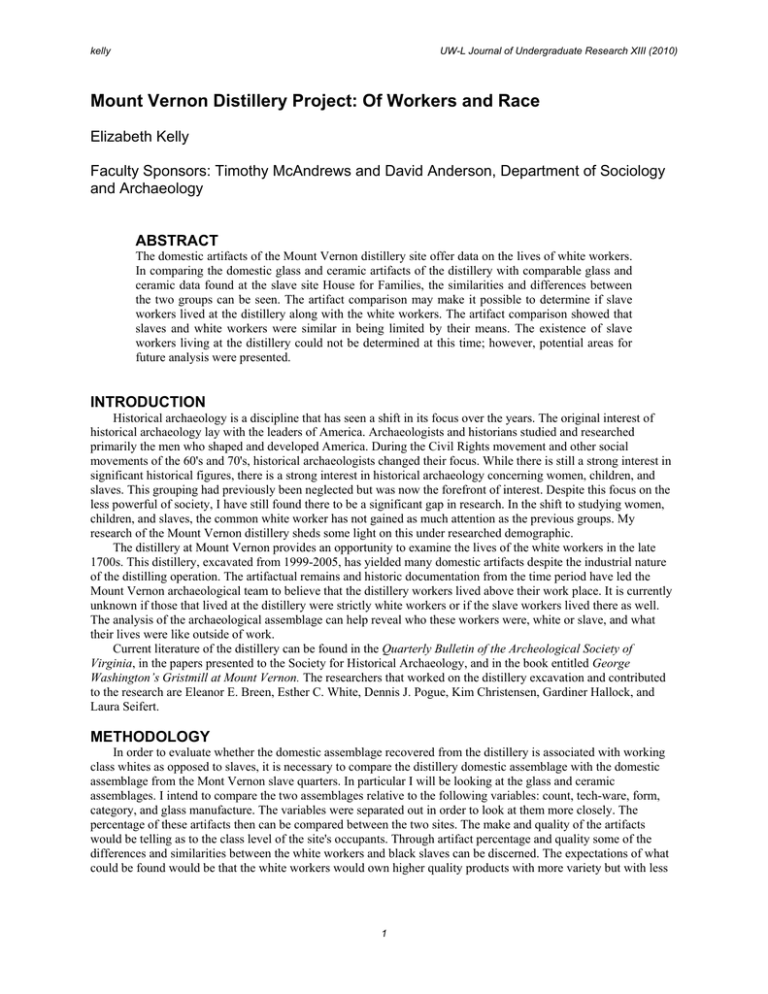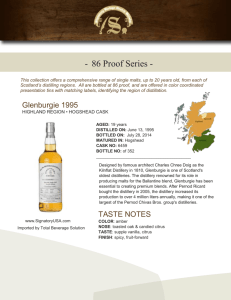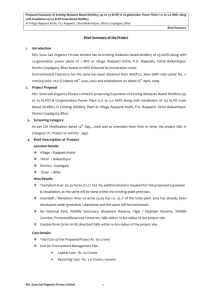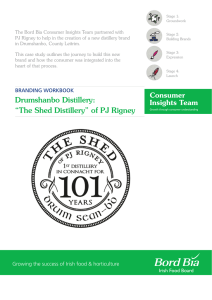Mount Vernon Distillery Project: Of Workers and Race and Archaeology
advertisement

kelly UW-L Journal of Undergraduate Research XIII (2010) Mount Vernon Distillery Project: Of Workers and Race Elizabeth Kelly Faculty Sponsors: Timothy McAndrews and David Anderson, Department of Sociology and Archaeology ABSTRACT The domestic artifacts of the Mount Vernon distillery site offer data on the lives of white workers. In comparing the domestic glass and ceramic artifacts of the distillery with comparable glass and ceramic data found at the slave site House for Families, the similarities and differences between the two groups can be seen. The artifact comparison may make it possible to determine if slave workers lived at the distillery along with the white workers. The artifact comparison showed that slaves and white workers were similar in being limited by their means. The existence of slave workers living at the distillery could not be determined at this time; however, potential areas for future analysis were presented. INTRODUCTION Historical archaeology is a discipline that has seen a shift in its focus over the years. The original interest of historical archaeology lay with the leaders of America. Archaeologists and historians studied and researched primarily the men who shaped and developed America. During the Civil Rights movement and other social movements of the 60's and 70's, historical archaeologists changed their focus. While there is still a strong interest in significant historical figures, there is a strong interest in historical archaeology concerning women, children, and slaves. This grouping had previously been neglected but was now the forefront of interest. Despite this focus on the less powerful of society, I have still found there to be a significant gap in research. In the shift to studying women, children, and slaves, the common white worker has not gained as much attention as the previous groups. My research of the Mount Vernon distillery sheds some light on this under researched demographic. The distillery at Mount Vernon provides an opportunity to examine the lives of the white workers in the late 1700s. This distillery, excavated from 1999-2005, has yielded many domestic artifacts despite the industrial nature of the distilling operation. The artifactual remains and historic documentation from the time period have led the Mount Vernon archaeological team to believe that the distillery workers lived above their work place. It is currently unknown if those that lived at the distillery were strictly white workers or if the slave workers lived there as well. The analysis of the archaeological assemblage can help reveal who these workers were, white or slave, and what their lives were like outside of work. Current literature of the distillery can be found in the Quarterly Bulletin of the Archeological Society of Virginia, in the papers presented to the Society for Historical Archaeology, and in the book entitled George Washington’s Gristmill at Mount Vernon. The researchers that worked on the distillery excavation and contributed to the research are Eleanor E. Breen, Esther C. White, Dennis J. Pogue, Kim Christensen, Gardiner Hallock, and Laura Seifert. METHODOLOGY In order to evaluate whether the domestic assemblage recovered from the distillery is associated with working class whites as opposed to slaves, it is necessary to compare the distillery domestic assemblage with the domestic assemblage from the Mont Vernon slave quarters. In particular I will be looking at the glass and ceramic assemblages. I intend to compare the two assemblages relative to the following variables: count, tech-ware, form, category, and glass manufacture. The variables were separated out in order to look at them more closely. The percentage of these artifacts then can be compared between the two sites. The make and quality of the artifacts would be telling as to the class level of the site's occupants. Through artifact percentage and quality some of the differences and similarities between the white workers and black slaves can be discerned. The expectations of what could be found would be that the white workers would own higher quality products with more variety but with less 1 kelly UW-L Journal of Undergraduate Research XIII (2010) artifacts due to the fact only workers lived at the distillery. The other expectation would be that the slaves would own lower quality products with less variety but in higher numbers due to the presence of families. BACKGROUND Mount Vernon Mount Vernon was founded in 1659 by George Washington's great-grandfather, John Washington. The property where the mansion would eventually stand was then known as Little Hunting Creek. George Washington's older half-brother, Lawrence Washington, renamed the property Mount Vernon after his commander Admiral Edward Vernon when he inherited the property in 1743 from his father Augustine Washington. George Washington at the time inherited the smaller property known as Fredericksburg. Lawrence Washington died in 1752 and Mount Vernon went to his widow and his daughter. However his wife remarried within six months of his death and his daughter died two years later. In 1754, Mount Vernon was then passed on to George Washington; he was only 22 (Dalzell and Dalzell 1998). The Mount Vernon distillery was a response to the growing popularity of whiskey over rum in the 1790s. Washington had originally focused on tobacco planting but in the 1760s his shift turned to the farming of wheat and production of flour (Breen and White 2004). Corn was also planted for animals and workers (Pogue 2004). However, the planting and maintenance of wheat, which is less labor intensive than tobacco production, left Washington with a surplus of slave labor. The surplus slave labor made possible other ventures, such as cloth production, shoe making, and the maintenance of a fishery and a copper, all of which contributed to the plantation’s self sufficiency (Breen and White 2004). Washington also had a fishery on the Potomac River, which yielded shad and herring, which both supplemented the plantation’s income and provided food for his slaves. Washington’s blacksmiths served plantation as well as neighboring plantations, which brought in some revenue. Washington also made a stud fee from his stallions. Despite these efforts, Mount Vernon lacked a steady cash income as payment usually was in a barter form (Pogue 2004). Washington was considering selling parts of his plantation (Breen and White 2004). His plan was to rent out the four outlying Mount Vernon farms along with his land in the west. If he did went through with these plans he would end up freeing 276 slaves (Pogue 2004). In the end, Washington was unable to find a buyer willing to pay his asking price, so he instead decided to try to increase revenue without piling on even more effort onto himself (Pogue 2004). It was James Anderson in 1796, an immigrant from Scotland and one of Washington's plantation managers who suggested the building of a whiskey distillery. Anderson knew of distilling from his native Scotland and promoted the idea of whiskey distilling near the plantation's gristmill, about three miles from the mansion. According to Anderson, the distillery would be a natural fit with the gristmill. Washington agreed to change the Cooper's Shop for the set up of two stills (Breen and White 2004). The week of February 22, 1797 80 gallons were distilled and stored in Anderson's cellar. That year over 600 gallons were produced. Anderson was convinced that this would be a profitable venture and in June proposed a larger whiskey operation to Washington (Breen and White 2004). Washington asked the advice of friend John Fitzgerald, a rum distiller, about accepting Andseron's proposal, and Fitzgerald supported the venture. Washington made sure that Anderson understood that he was only doing this because of the profits it would generate (Pogue 2004). Construction started the week of October 7, 1797 and was completed in March 1798. The building was 75 by 30 feet and built of sandstone. Inside it had five pot stills with a combined capacity for 616 gallons, a broiler, and a wooden mash tub. The nearby gristmill was the source of processed grain, fuel came from the local woods, and water was supplied by a well dug specifically for the distillery and the water was on a gravity-propelled system (Breen and White 2004). Typical distilling of the time was done out of small sheds by farmers, usually for one or two months a year. These farmer-distillers used their own grain and it was not a for-profit venture. Merchant-distillers however, bought grain and built their own buildings for the primary use of distilling. Washington's distillery was planned and built specifically for commercial use, making him one of the first Merchant-distillers (Hallock and Seifert 2004). It has been proposed that the upper floor of the distillery was a living area for the workers. While the slaves who were employed at the distillery are known by name, age, and were known to have been owned by Martha Washington, it is unknown if they lived at or near the distillery. No slave quarters associated with the distillery are mentioned in historic documents and none have been recovered archaeologically. The upper quarters of the distillery were known to house at least two white workers. John Anderson was the name of the distiller and he had at least one white assistant named Peter Bingle (Breen and White 2004). Aside from Anderson and Bingle, there is no documentation on where the other workers lived (Hallock and Seifert 2004). 2 kelly UW-L Journal of Undergraduate Research XIII (2010) The distillery was the largest in the country at the time and was an industrial endeavor as opposed to the smaller house productions and it was very successful for the few years it was in operation. In 1797 it produced over 600 gallons and made a profit of £83, 4500 gallons with a profit of £334 in 1798, and 11,000 gallons with a profit of £600 in 1799. The whiskey was produced mostly for local consumption, with about 45% of the whiskey was bought by 12 merchants from Alexandria, Virginia for commercial resale (Breen and White 2004). The distillery also brought benefits to the plantation. Slop made from the distilling mash was considered good feed for cows and pigs. Stalls for cows were built in the spring of 1798 and for hogs that fall (Hallock and Seifert 2004). The slops were highly nutritious for these animals and fattened them up quickly and efficiently. This use of the distillery was appealing to Washington as he then was able to fetch higher prices for his livestock (Pogue and White 2005). Washington died in the December of 1799. Nellie and Lawrence Lewis, Washington's step-granddaughter and nephew inherited the site, and the distillery appears to have been in operation until 1804 when Anderson relocated. James Douglass, a merchant from Alexandria, leased the distillery and was selling whiskey in 1808. The distillery was abandoned by the time it burned down in 1814 (Breen and White 2004). Excavation and Reconstructions In 1995 Mount Vernon gained an extra 6.5 acres of the Mount Vernon plantation, which included both the Gristmill and Distillery, from the state of Virginia, under which the land was part of a state park. This area was systematically surveyed in 1997 and the locations of many important sites were verified. During the 1999 and 2000 seasons, the distillery was excavated in order to determine the site's potential. When the distillery was determined to be of historical and archeological value, Mount Vernon sought assistance from the trade association, the Distilled Spirits Council of the United States, or DISCUS. With the support of DISCUS, the full excavation began in 2001 (Christensen 2004). The site of the distillery itself is unique. The distilleries of the 18th century have neither survived nor have been fully excavated before the effort was undertaken at Mount Vernon (Pogue and White 2005). The site was over 4000 square feet, with the distillery footprint measuring 75 x 30 foot. Disturbed soil was evidence for the excavation that went on in 1930. There was also evidence for a trench that went around the entire site, this trench was left over from when the foundation stones were robbed and put to other uses (Breen and White 2004). Intact foundations were found on the south and west walls along with part of a partition. The remains of brick and cobblestone point to being the remains of the floor along with findings of floorboards. The makeup of the floor leads to the belief that this is where the fermentation took place, as the floor would have to be very stable to prevent vibrations. Burn marks from stills were found in the brick and soil. Drains were found in the same area, as water would need to flow for the cooling process of distilling. Evidence for placement of the fireboxes, which would have been for the boiler, was found through burns on some of the bricks. The site's north end shows evidence of a two-foot thick stone wall. Documentation shows that this partitioned area was the above ground cellar, which held the barrels of whiskey. This area was also divided to allow for an office for the distillery manager. Evidence for living quarters was also found mostly in the northern section of the site. While many domestic artifacts have been found, very little has been found that had direct involvement with the distilling process, most likely because the items were removed before the building was abandoned (Pogue and White 2005). CONTEXT White Workers Information concerning the employed white male workers at Mount Vernon appears to be slim to un-findable when looking at them in a general sense. Most information that is available pertains to the workers on an individual level. This does make research into this area difficult. James Anderson was born in Scotland and apprenticed as a farm manager in England and later immigrated to America. During his years in Scotland and Virginia he gained experience in distilling whiskey. Washington employed Anderson as the plantation manager in 1797. Anderson's responsibility in directing the plantation included the overseers, craftsmen, the fishery, and farming. It was Anderson who suggested the building of a distillery to Washington as a new source of profit for the plantation. Anderson was critical in the creation of the distillery. His son John Anderson became the distillery's manager. After Washington's death in 1799, the Anderson family continued to work at Mount Vernon until Martha Washington's death in 1802. The family then moved to work on the plantation owned by Martha Washington's grandson George Washington Parke Custis near Williamsburg (Pogue and White 2005). It is known that John Anderson lived above the distillery. His presence there as a manager, could have an affect on the artifact assemblage. As the manager, he would have been entitled to a higher pay than the workers under him. 3 kelly UW-L Journal of Undergraduate Research XIII (2010) Because of this, he could have had access to items the other workers did not. And if any of the artifacts found belonged to him, the artifact record could have a bias towards a higher class than if the workers lived in the distillery without a manager present. Slaves A property as large as Mount Vernon, had need of a large slave population in order to keep it running. By the time of Washington's death, 317 slaves were either owned or rented by him. However, of this number 132 were not age appropriate for work. A number of these slaves had come in with Martha Washington or from Lawrence Washington. Over the years George Washington had managed to purchase a number of his own. It was noted by visitors that Washington's slaves had lives fairly better than those at other plantations as Washington believed that slaves that were cared for worked harder. Their homes were simple log huts with dirt floors. Food provisions were provided but was often supplemented with what could be grown in small garden plots, raised chickens, and fished and trapped wild animals (Dalzell and Dalzell 1998). The site known as House for Families was the main slave quarters for the plantation, located near the mansion house. It was built in the 1760s and was torn down in 1793 in favor of new slave quarters at the greenhouse. The excavation of House for Families, specifically the cellar, began in 1984 and was completed by 1991. This slave site is known for it's domestic artifacts (Mount Vernon Ladies' Association). There are six known slaves that worked at the distillery and, expect for one slave that was on loan by one of Washington's neighbors, were all dowry slaves owned by Martha Washington. These slaves were unmarried men between the ages of 14 and 24, most likely used for the physical labor aspect of the distilling job as opposed to working the stills. It is thought that slaves owned by Martha Washington were chosen for the job because Washington wanted the distillery to continue running after he died and passed the property to one of his stepgrandchildren in his will (Breen and White 2004). If any slaves did live at the distillery, it could have been these laborers. Alcohol and Distilling Distilling is a complex form of alcohol production, requiring care during the heating process and precision when using the fermented product in a still or alembic. The art of distilling was slow to rise in popularity, originally being limited to pharmacies in Europe. It was in the seventeenth century that distilling came into its own. This was partially due to the sugar plantations in the Caribbean. The sugar harvested was used for molasses that was necessary for rum distilling. Rum distilling is mostly associated with the Caribbean but has been found in North America as well. Whiskey distilling, the type produced at Mount Vernon, has been found linked to farm production. Whiskey was used as a means of increasing revenue, which had the added affect of strengthening the relationship between the farmer and the community. Whiskey distilling seems to have been popular in North America, where illegal whiskey distilling gave rise to moonshine (Smith 2008). After the American Revolution, molasses based rum fell into disfavor, partially from the expense of shipping all the way from the Caribbean and also because molasses was a British product. Whiskey was cheaper and more patriotic. The grain used, corn, rye, and malted barley, was locally available and their combining was rather easy. The process of distilling whiskey was to allow the main ingredients, plus water and yeast, to ferment for at most five days. After that, the mixture would be poured into a copper still and heated. The vapor that rises would rise through a tube, cool, and condense, leaving the alcohol in another still. This process was then repeated to raise the proof and remove more impurities (Pogue and White 2005). The end product of the distilling process was dependent on the skills and work ethic of the distillery workers. The quality of the whiskey and the amount available to sell was dependent on their work. As it is known that the Mount Vernon distillery was profitable, the workers were probably well compensated in return. This would have an affect on the artifacts discovered, as the workers would be able to purchase items that would not be available to less competent workers. DATA AND RESULTS In viewing the comparable artifacts found at both the distillery and the slave quarters know as House for Families, patterns begin to emerge. Through these patterns one can see how life was for both the workers and the slaves. 4 kelly UW-L Journal of Undergraduate Research XIII (2010) Figure 1. Ceramic Tech-ware comparision between the distillery and House for Families by percentage Figure 1 shows the distribution of the shared ceramic tech-ware for the distillery and House for Families. It appears that whatever type was used more at one site was used less at the other. While creamware is common at the distillery but found less at House for Families, Chinese porcelain is most common at House for Families but have very few examples at the distillery. Creamware was originally developed as tableware by English potters and most likely would have served a similar purpose at the distillery. Creamware was the first type a of earthenware to be in common use (Ramsay 1947). The creamware, along with the other ceramics, most likely would have been American made due to the American Revolution affecting trade (Spargo 1926). The high amount of Chinese porcelain goes against what I had expected to be present in a slave quarter's context. It could be hypothesized, that with large presences of porcelain, the slaves might have been receiving "hand-me-downs" from Washington's mansion along with their usual supplies. The only type where both sites had similar amounts was whiteware, though neither had much. The reason for this cannot be told through numbers, further research is needed. However, in reasoning with my hypothesis that slaves gained unwanted "hand-me-downs" from the mansion, the slaves simply had access to items the distillery works did not. The distillery workers instead would have had to purchase their own ceramics which, being of a lower class and not as rich, would most likely not have been like the types Washington owned. 5 kelly UW-L Journal of Undergraduate Research XIII (2010) Figure 2. Ceramic forms comparision between the distillery and House for Families by percentage Figure 2 shows the comparision of shared ceramics forms between the distillery and House for Families. There seems to be a rather even amount of the common ceramic forms for both the white workers and the slaves. This could mean that their needs when it came to ceramics were similar. These needs appear to have been primarily for dining purposes. The noticable difference is when it comes to tea bowls. While they make a very low overall percentage, when compaired to eachother, the distillery had more tea bowls than House for Families. While the few found at House for Families does indicate that tea bowls were being obtained in some fashion, the higher rate in the distillery would suggest a higher availability for the white workers. Figure 3. Ceramic vessel compairison comparision between the distillery and House for Families by percentage 6 kelly UW-L Journal of Undergraduate Research XIII (2010) Figure 3 is a comparision of ceramic vessel types shared by the distillery and House for Families. For both flatware and hollowware, House for Families had more than was found at the distillery, though the gap is larger when looking at flatware. This I believe may be due to a population difference. There would have been families in House for Families and therefor more people living there while the distillery would have only housed a few workers. There may be another factor for the puzzling difference for flatware while hollowware has less of a difference, but with the current data I could not figure a hypothesis. As all the ceramics, as the data was presented, were placed in these simple categories I believe that that despite the variety of ceramics owned by the slaves and distillery workers, they were limited in the utility of the ceramics. The unidentifiable remains should be further studied in regards to ceramic's practicality or decorative use. As of right now, it does not appear that any of the ceramics were of a purely decorative nature. Figure 4. Manufacture of glass comparision between House for Families and the distillery by percentage Figure 4 shows the distribution of shared glass manufacture techniques between the distillery and House for Families. As can be seen, both House for Families and the distillery had more mouth blown glass than mold blown glass. Mouth blowing is a method that requires a skilled craftsmen and time as glass could only be worked while hot and it takes effort to keep the glass piece symetrical. Mold blown allowed for more complex patterns and consistency between pieces along with being a quicker method (McKearin and McKearin 1941). The glass found at both House for Families and the distillery shows one of the stronger similarities between the two sites. The availability of different glass types may have been determined by an economic or social factor. This factor was most likely shared between the slaves and white workers and could have set them apart from other groups that would have acquired more mold blown glass. Mouth and mold blown glass and their avalibility should be further studied in order to better understand what factors made the slaves and white workers so similar in this regard. 7 kelly UW-L Journal of Undergraduate Research XIII (2010) Figure 5. Wine bottle comparison between House for Families and the distillery by percentage Figure 5 shows the comparision between the amount of wine bottle found at the distillery compaired to House for Families. Wine bottles in the distillery context make up the vast majority of glass objects, nearly 50% of glass found at the distillery. Wine bottles were found in the slave context but of a much lower level than at the distillery. While the distillery was an alcohol producing site, whiskey was known to have been stored in barrels rather than glass bottles. The bottles would have most likely have come from an outside source. I have hypothesised that the reason for the difference could be to a potential ban on slaves consuming alcohol while no such ban was made for the white workers. This could create distinct artifact characteristics between slave and white worker sites. Other known slave and white worker sites should be analyized for alcoholic evidence, along with written historical documentation, to see if such a difference is present elsewhere and if such a ban did exist. 8 kelly UW-L Journal of Undergraduate Research XIII (2010) Figure 6. The distribution of ceramic pipes at the distillery and House for Families by percentage Figure 6 shows the differences in the amound of ceramic pipes found at the distillery and House for Families. While an overall small amount, House for Families clearly has more than the distillery. Naturally, the flammability of the whiskey would be a deterrent for smoking, but pipes were still found at the distillery indicating that they were still used at some point. While ceramic pipes are by no means rare in Virginia, I believe that the pipes found at House for Families and at the distillery should be closely examined as I think that it is the pipes that could be a clue towards the question of if slaves lived at the distillery or not. Particularly, markings and decorations on the pipes should be noted. According to Leland Ferguson (1992) there have been pipes found in Virginia that had African markings on them, which would link those pipes to having been used by slaves. While the presence of these types of markings can not be confirmed by me, I believe that it is an aspect that should be analyzed. DISCUSSION The comparison of the glass and ceramic artifacts at the distillery and House for Families provides a small glimpse into their lives. I do not believe that it could be said, as the data has been presented, that there is any one artifact that could be seen definitively as "slave" or "white worker." This does not mean that none exist. The discrepancy of wine bottles and pipes is notable and further analysis may bring to light more stepping stones in the direction of discovering whether or not slaves lived at the distillery. What I believe has been shown is the similarities between slaves and white workers. While the slaves owned different ceramics than the white workers, I have doubt that the slaves got to choose their ceramics. The white workers on their end would have had to buy their ceramics on their own. In other words, both groups were severely limited by their means. This would account for the range of ceramics; sets were created by what was available to them. The glass artifacts appear to be on about the same level for both groups in terms of quality. Hand blown glass seems to have been the type of glass most available for both the slave and white workers. This shows that slaves and white workers had some common factor that made mouth blown glass the more available glass type for them as opposed to using mold blown or other glass types. Both groups had have a use of their items, most of which appears to have been related to dining. Little, if any, was left over for strictly decoration purposes. In this sense, practicality and need was important when it came to obtaining personal objects. I would conclude from the data that slaves and white workers were close when it came to class level. CONCLUSION This project, in analyzing the glass and domestic artifacts found at the Mount Vernon distillery with comparisons to the slave site House for Families, is not searching for absolute answers. My ultimate goal is merely 9 kelly UW-L Journal of Undergraduate Research XIII (2010) to shed some light and give insight into what the distillery data means. My analysis also provides a springboard of questions for future research into this area. The major aspect that should be taken up by future research would be to compare the distillery domestic artifacts with domestic artifacts of different classes. Namely, there should be a comparison to a higher class site in order to perceive a full spectrum. Other areas for future research have been peppered throughout this project and it is a regret that I am not capable of exploring these avenues any further. However, I do believe that my research is important and will be of assistance in the future. At the very least, it was a rewarding experience. REFERENCES Breen, Eleanor E. 2004 Whiskey in the Rocks: Excavating and Interpreting the Archaeological Remains of George Washington's Distillery. Paper presented at Society for Historical Archaeology, St. Louis. Breen, Eleanor E., and Esther C. White. 2006 "A Pretty Considerable Distillery": Excavating George Washington's Whiskey Distillery. Quarterly Bulletin of the Archeological Society of Virginia 61 (4) 209-220. Dalzell, Robert F. Jr, and Lee Baldwin Dalzell. 1998 George Washington's Mount Vernon: A Home in Revolutionary America. Oxford University Press, New York. Ferguson, Leland. 1992 Uncommon Ground: Archaeology and Early African America, 1650-1800. Smithsonian Institution Press, Washington. Hallock, Gardiner, and Laura Seifert. 2004 "To Erect a Large Distillery:" An Architectural Reconstruction. Paper presented at Society for Historical Archaeology, St. Louis. McKearin, George S., and Helen McKearin. 1941 American Glass. Crown Publishers, New York. Mount Vernon Ladies' Association 2010 House for Families. Internet, http://www.mountvernon.org/learn/pres_arch/index.cfm/sss/83//cfid/30930255/cftoken/11271900, accessed February 2010. Pogue, Dennis J. 2004 Shad, Wheat, and Rye (Whiskey): George Washington, Entrepreneur. Paper presented at Society for Historical Archaeology, St. Louis. Pogue, Dennis J., and Esther C. White 2005 George Washington’s Gristmill at Mount Vernon. Mount Vernon Ladies’ Association, Mount Vernon, Virginia Ramsay, John. 1947 American Potters and Pottery. Tudor Publishing Co., New York. Smith, Fredrick H. 2008 The Archaeology of Alcohol and Drinking. University Press of Florida, Gainesville. Spargo, John. 1926 Early American Pottery and China. The Century Co., New York. 10





